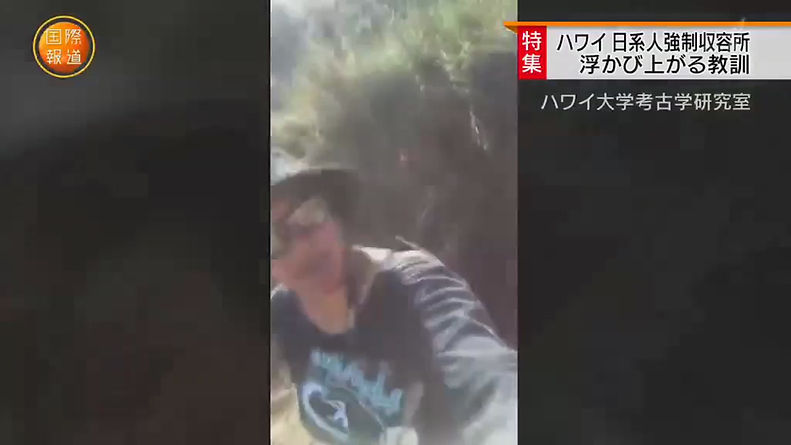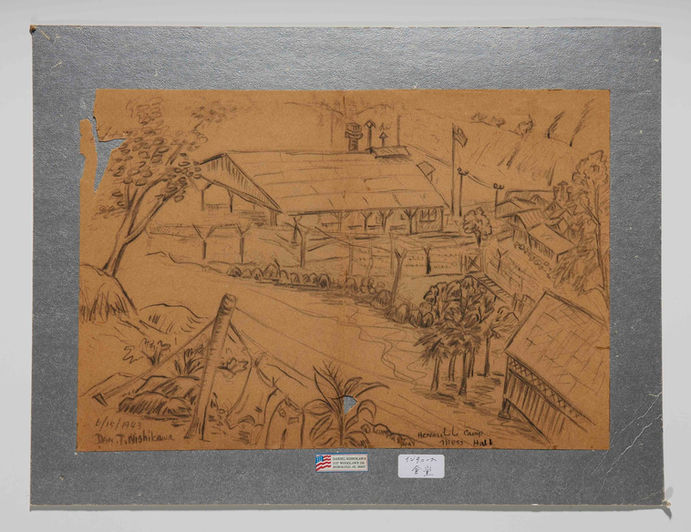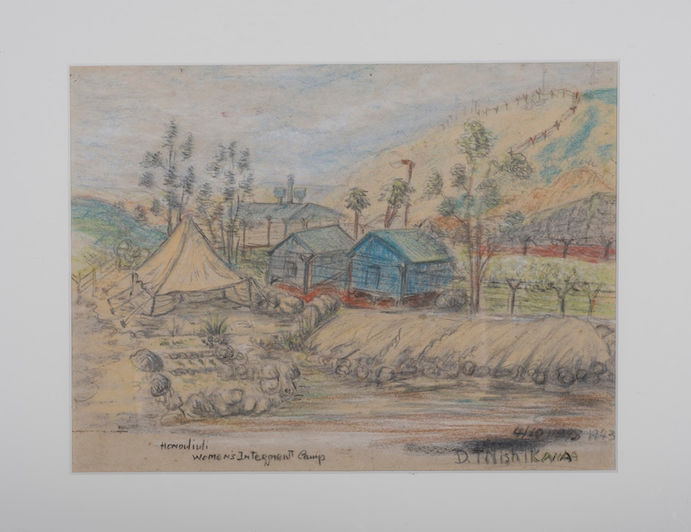



HONOULIULI NATIONAL HISTORIC SITE
Imperial Japan’s 1941 attack on Pearl Harbor in Hawai'i resulted in the U.S. entering WWII and the opening of incarceration camps, across North America, including the Honouliuli internment camp on Hawai'i’s island of O'ahu. With Japan expanding into the South Pacific, battles with the U.S. ensued between 1941 and 1945. Meanwhile, U.S. hostility towards Japanese American citizens intensified as 110,000 people were forcibly removed from their homes to American concentration camps across the U.S. Recognizing this tragic period of history, on February 19th, 2015, President Barack Obama signed a proclamation designating the Honouliuli Internment Camp site a national monument. On March 12th, 2019, the monument was redesignated and officially became the Honouliuli National Historic Site. In March 2021, the National Park Service appointed its first superintendent, Hanako Wakatsuki, to the site.

This page features several organizations' efforts to reconstruct this history and expose the injustice that occurred here.
Japanese Cultural Center of Hawai'i (JCCH) and the Honouliuli Interment Camp
Located in Honolulu, Hawai'i, the mission of the Japanese Cultural Center of Hawai'i (JCCH) is to teach people about Japanese Americans’ heritage. Volunteers located the Honouliuli internment camp in 2002. In 2006, JCCH substantiated an archaeological examination of World War II confinement sites in Hawai'i. The Honouliuli internment camp, located in the Honouliuli ahupua'a of O'ahu, was one of those sites. In addition to archaeological excavation, for educating about the impacts of interment and WWII on Japanese Americans, JCCH has also engaged in archival and ethnographic research at the site.
Former Internee Drawings Presented by the Japanese Cultural Center of Hawai'i (JCCH)
Dan Toru Niskikawa sketched, in pencil, his recollection of how the outside of the mess hall appeared. With the use of colored pencils, Dan Toru Nishikawa drew the portion of the camp where the women were interned. He used colored charcoal to draw the road to the guard tower.
Dan Toru Nishikawa Collection at JCCH
Click on an Image for a Closeup View and Description.
UH West O'ahu Research and the 2006-2017 Archaeological Research by Jeff Burton
and Mary Farrell
The main goal of the 2006-2017 archeological research undertaken by Jeff Burton and Mary Farrell was to locate and find remnants of the internment camp with the help of the JCCH. Findings from Farrell's (2017) report are detailed here as well as in the slideshow on the Home page. Methods used included mapping and taking photographs. When the University of Hawai'i West O'ahu began helping there, excavation started uncovering more features such as mess halls and the foundations of their showers. Artifacts remained in both the internment of civilians and prisoner of war (POW) areas at the camp. The final report indicates that 175 features, from when the camp was active, were identified.

University of Hawai’i-West O’ahu. Archaeological Field Techniques Course at Honouliuli. July 14, 2014.
During this time, prior to the 2016-2019 research by Dr. William R. Belcher, UH West O'ahu faculty from 8 different academic disciplines were engaged in research involving the collection of oral histories and archival documentation. Research sought to understand the impacts of WWII confinement in Honouliuli and did so through archaeological findings, historical accounts, ethnographic field work, as well as through sociological and psychological perspectives. Involved scholars included community partners from the Japanese Cultural Center of Hawai'i, Densho, King Kamehameha V Judiciary History Center, and the National Park Service that were also a part of this project. Edited by Drs. Suzanne Falgout and Linda Nishigaya, this work was published by the University of Hawai'i Press as a collection of articles in the 2014 book entitled:
Breaking the Silence: Lessons of Democracy from the World War II Honouliuli Internment and POW Camp in Hawai'i.

Archaeological Research 2016-2019 by Dr. William R. Belcher and UH West O'ahu Students
Through funding support from the NPS, Dr. Belcher taught the 2016-2019 archaeology field school offered through UH West O'ahu. Each summer, students majoring in anthropology and/or completing a certificate in applied forensic anthropology participated in the field school at Honouliuli National Historic Site. Over the summer of 2020, 29% of former students were interviewed. Common interview themes illustrated students appreciation of learning from Dr. Belcher's 30+ years of experience as both an archaeologist and one of the world’s leading forensic anthropology experts. They spoke of their newfound excitement for archaeology and wanting to find careers related to it. Interviewees further spoke of their appreciation for the camaraderie they experienced during the field school and how they felt it was an honor to be a part of reconstructing and exposing this dark chapter in history. UH West O'ahu students, upon receiving their B.A. in anthropology, are commonly employed as archaeologists working for cultural resource management organizations in Hawai'i.

The group photo is of the 2019 field school. This field school was comprised of all women reflecting an equity shift within archaeology as more women are entering the field.
To learn more, read Dr. Belcher's (2020) article published in Hawaiian Archaeology that further details the 2016-2019 field school and its findings or his reports on the 2016 & 2017, 2018, and 2019 field seasons.
Students’ Photographs Taken During Dr. William R. Belcher’s 2016-2019 Annual Summer Field School
Please Click on an Image to Learn More About It
Broadcasted Video Featuring UH West O'ahu Anthropology Students
December 2019, for the 78th Anniversary of Pearl Harbor Remembrance Day, the NHK BS International News Channel broadcasted a video of the Honouliuli National Historic Site and those involved. Former anthropology field school students Jadelyn Akamine, Erik Castaldo, Kristie Ann Gose, and Rachel Williamson were interviewed for the story. The news team interviewed the students in the archaeology/forensic anthropology lab at UH West O'ahu, where they showcased their photos and reflected on their field school experiences during Dr. Belcher's course. Featuring the interview with the students, the video below plays minutes 7:39-8:25 of the longer news story.

Interviews of 2016-2019 UH West O'ahu Field School Students & Interviewees' Photos
Research during years 2020 to 2021 consisted of documenting formers field school students’ experiences. Two former field students, Jadelyn Akamine and Rachel Williamson, were hired to interview other former field school students. Below is the interview question protocol that they used and co-developed with Dr. Christy Mello. Dr. Mello provided guidance on how to conduct interviews as seen in the protocol document.
Click Here to View the Interview Questions Protocol Document
Below are examples of students’ responses to the questions:
How were you impacted by being a part of the field school?
"Ah, for one, I feel privileged that we got to do this because this place is it is-it is park already and it is a national monument but it is not really accessible to the public yet, it will be one day and that is largely because of what we have been doing. So, we are, um, literally resalvaging history that was intentionally deleted for people to learn from. And I just think that is incredibly important. We are able to give lessons to people in the future, ah, based-off of what we are uncovering [inaudible]. It has been essentially the whole point of Archaeology."
Did you think about what people experienced at that time in history, either living in or outside of the internment camp?
"Definitely. I mean you’re there doing this work and of course with Dr. Belcher who has done a lot of these digs, has a lot of, I guess, background in interpreting context. He says 'while you guys are doing this, think about this and constantly thinking about the past and what these people might be experiencing. Why these things are found in this place, this time and at this level. Ultimately, I can’t ever imagine going through what they went through."
Do you feel connected to this place, maybe feeling a sense of awe or just enjoying being in that space?
"Every morning, again I thought it was an honor going there and every morning in the truck to work, or in the van or whatever. I knew I was going to have a good day, it’s just a powerful place out there. It’s really, it’s almost like uh, uh a religious monument or something. People like talk quietly out there, not everybody but a lot of people. I mean it just feels like, I know what happened out there but it feels like something bad happened out there and we are trying to make it better again (...). Being out there was very powerful, I still, even before I was doing this I still think about how much I enjoyed that experience."
Interviewees shared the images below:
Please Click on an Image for a Closer Look & Photo Credit













